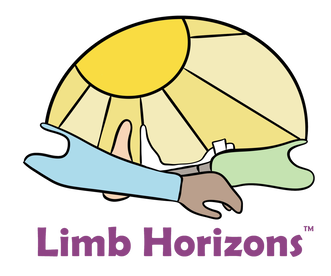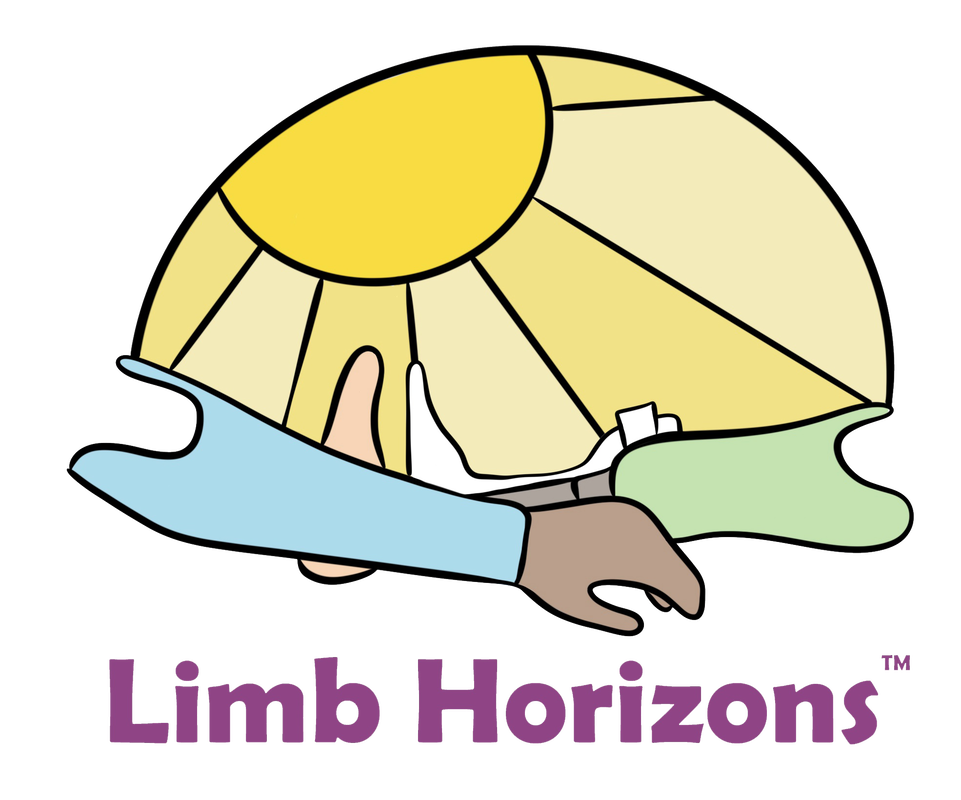It's fun to learn new, big words. Knowing how to talk about your brace or prosthetic limb can help you express yourself. This glossary includes words that you may hear a lot when people are talking about your brace or prosthetic limb. Imagine how surprised the grown ups will be when you use these big words too!
Abbreviation
An abbreviation is a shortened form of a word.
An abbreviation is a shortened form of a word.
Advocate
An advocate is a person who supports themselves or others. If you advocate for someone, you 'speak up for' that person.
An advocate is a person who supports themselves or others. If you advocate for someone, you 'speak up for' that person.
Amputation
Amputation is when part of the body, such as a limb, is removed during surgery or in an accident.
Amputation is when part of the body, such as a limb, is removed during surgery or in an accident.
Ankle Foot Orthosis (AFO)
An AFO is a brace designed to support the ankle and foot.
An AFO is a brace designed to support the ankle and foot.
'Blade' Running Foot
A special type of prosthetic foot that is shaped to help a person run really fast. This type of foot is shaped differently and does not have a foot shape.
A special type of prosthetic foot that is shaped to help a person run really fast. This type of foot is shaped differently and does not have a foot shape.
Bilateral
Bilateral means two, or both, sides (left and right).
Bilateral means two, or both, sides (left and right).
Brace
A device that supports a part of the body to make it stronger.
A device that supports a part of the body to make it stronger.
Cerebral Palsy (CP)
Cerebral palsy is a condition that a person is born with. A person with CP has a brain that works in a special way and this makes the body move in a special way. CP can also affect other activities, like speaking. Sometimes a person with CP can use bracing to help support body parts, like the ankle and foot.
Cerebral palsy is a condition that a person is born with. A person with CP has a brain that works in a special way and this makes the body move in a special way. CP can also affect other activities, like speaking. Sometimes a person with CP can use bracing to help support body parts, like the ankle and foot.
Endoskeletal Prosthesis
In an endoskeletal prosthesis, there is no hard, outer shell covering the prosthetic parts, like the foot or knee. Sometimes you can see the prosthetic parts in an endoskeletal prosthesis, while sometimes they are covered for a soft, foam cover.
In an endoskeletal prosthesis, there is no hard, outer shell covering the prosthetic parts, like the foot or knee. Sometimes you can see the prosthetic parts in an endoskeletal prosthesis, while sometimes they are covered for a soft, foam cover.
Exoskeletal Prosthesis
An exoskeletal prosthesis is a prosthesis that is covered in a hard, outer shell. EXO means 'outside'. It's like having bones on the outside!
An exoskeletal prosthesis is a prosthesis that is covered in a hard, outer shell. EXO means 'outside'. It's like having bones on the outside!
Fibula Hemimelia
When a child is born with fibula hemimelia, the fibula is either short or missing.
When a child is born with fibula hemimelia, the fibula is either short or missing.
Myoelectric
A myoelectric prosthesis uses signals from muscles (myo) to activate electrodes (electric) in a computerized prosthesis. The electrodes are externally placed against certain muscles that, when flexed (sometimes referred to as 'fired), send signals to the prosthetic elbow and/or hand. Those signals tell the computerized component how to move. For example, firing a certain muscle in the residual limb will tell a prosthetic hand to open or close its grip.
A myoelectric prosthesis uses signals from muscles (myo) to activate electrodes (electric) in a computerized prosthesis. The electrodes are externally placed against certain muscles that, when flexed (sometimes referred to as 'fired), send signals to the prosthetic elbow and/or hand. Those signals tell the computerized component how to move. For example, firing a certain muscle in the residual limb will tell a prosthetic hand to open or close its grip.
Orthotist
An orthotist is a person who designs and makes orthotic bracing for people (and sometimes even for pets). An orthotist uses a combination of science and art to create each brace. To become an orthotist, a person has to go to college and receive extra schooling and practice.
An orthotist is a person who designs and makes orthotic bracing for people (and sometimes even for pets). An orthotist uses a combination of science and art to create each brace. To become an orthotist, a person has to go to college and receive extra schooling and practice.
Prosthesis
A prosthesis is an artificial limb used by a person who is missing a whole limb or part of a limb. Some people might call a prosthesis a 'robot' limb, or 'bionic' limb.
A prosthesis is an artificial limb used by a person who is missing a whole limb or part of a limb. Some people might call a prosthesis a 'robot' limb, or 'bionic' limb.
Prosthetic
Prosthetic is a word used to describe a prosthesis. A prosthesis may also be a call prosthetic arm or prosthetic leg.
Prosthetic is a word used to describe a prosthesis. A prosthesis may also be a call prosthetic arm or prosthetic leg.
Prosthetic & Orthotic Clinic
A prosthetic & orthotic clinic is a place where experts design and make prosthetic limbs and braces for people who need them.
A prosthetic & orthotic clinic is a place where experts design and make prosthetic limbs and braces for people who need them.
Prosthetist
A prosthetist is a person who designs and makes prosthetic limbs for people (and sometimes even pets). A prosthetist uses a combination of science and art to create each prosthesis. To become a prosthetist, a person has to go to college and receive extra schooling and practice.
A prosthetist is a person who designs and makes prosthetic limbs for people (and sometimes even pets). A prosthetist uses a combination of science and art to create each prosthesis. To become a prosthetist, a person has to go to college and receive extra schooling and practice.
Prosthosis
A brace that has a prosthetic foot attached to the bottom.
A brace that has a prosthetic foot attached to the bottom.
Proximal Femoral Focal Deficiency (PFFD)
PFFD is a condition that a person is born with. PFFD means that a person's hips and thighs do not fully form before birth. A person may have PFFD in one or both legs. There are many different types of PFFD and many different ways to help that person be active.
PFFD is a condition that a person is born with. PFFD means that a person's hips and thighs do not fully form before birth. A person may have PFFD in one or both legs. There are many different types of PFFD and many different ways to help that person be active.
Residual Limb
The residual limb is the part of the limb that you still have, even if part of the limb is missing.
The residual limb is the part of the limb that you still have, even if part of the limb is missing.
Supramalleolar Orthosis (SMO)
An SMO is a brace that support the foot just above the ankle.
An SMO is a brace that support the foot just above the ankle.
Tibial Hemimelia
When a child is born with tibial hemimelia, the tibia is either short or missing.
When a child is born with tibial hemimelia, the tibia is either short or missing.
Transfemoral
Transfemoral means across (trans) the femur portion of the leg (femoral). The femur is the high. A transfemoral prosthesis is used by someone who is missing their knee and foot.
Transfemoral means across (trans) the femur portion of the leg (femoral). The femur is the high. A transfemoral prosthesis is used by someone who is missing their knee and foot.
Transradial
Transradial means across (trans) the radius (the forearm). This is sometimes referred to us 'below elbow'.
Transradial means across (trans) the radius (the forearm). This is sometimes referred to us 'below elbow'.
Transtibial
Transtibial means across (trans) the tibia portion of the leg (tibial). The tibia is the leg calf.
Transtibial means across (trans) the tibia portion of the leg (tibial). The tibia is the leg calf.
Unilateral
Unilateral means one side (left or right).
Unilateral means one side (left or right).
|
Limb Horizons™ is on a mission to empower children and families by creating inclusive, imaginative online illustrated children's stories that promote prosthetic and orthotic education and limb difference awareness.
A passion project by Functional Restorations, LLC Notice: The information provided by Limb Horizons™ is not a substitute for professional medical advice. Please contact your medical professional for professional guidance. All rights reserved. The images and content on this site may not be reproduced or used in any manner whatsoever without the express written permission of Jennifer Latham Robinson except for personal use, brief quotations in a book review or scholarly journal. All images and content copyright 2022 by Jennifer Latham Robinson. |


